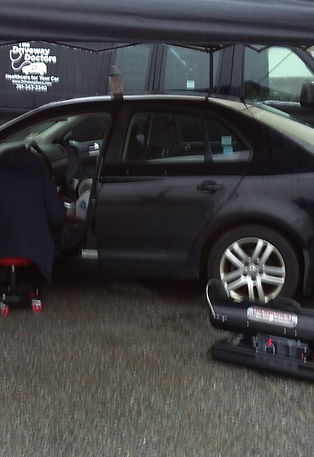
Car Electrical Service and Repair
The Driveway Doctors offer complete auto electrical services and repairs for all car makes and models. Our highly skilled professional technicians will assist you with your auto electrical problem - quickly and efficiently.
Car Electrical Troubleshooting
Troubleshooting car electrical problems can be a frustrating task. We need to keep three simple rules in mind: every circuit needs a power source; most electrical devices require a minimum voltage to function correctly; and all circuits require continuity. Consequently, most electrical problems are caused by either low or no voltage, excessive resistance, or a loss of continuity.
Safety Considerations
Safety is always an important consideration when working on automotive electrical systems. Except for the high voltage side of the ignition system and the high voltage battery and circuits in hybrid vehicles, there is no danger of being electric shocked. Twelve volts (12v DC) is not enough to be felt. The danger is accidentally shorting out a hot circuit and damaging the wiring, PCM or other onboard electronics, or starting a fire. We should always disconnect the battery to eliminate any risk of any accidental short. Disconnecting the battery causes most PCMs to forget their learned settings. This can cause drivability issues and require a special "relearn" procedure with a scan tool. To avoid this kind of hassle, we use a 9 volt "memory saver" that plugs into the vehicle's power receptacle or cigarette lighter to maintain voltage to the battery. You can also connect a 9 volt alkaline battery to the PCM power supply.

Electrical Circuit Checks
All electrical circuits require voltage to operate thecomponents connected to the circuit. If there is no voltage, there is no function. The first thing to do when troubleshooting electrical problems is to check for the presence of voltage at the load point in the circuit. The load point is the element that the circuit is supposed to power, such as a light bulb, wiper motor, blower motor, or an idle stop solenoid. For a quick check, we need a voltmeter or a 12-volt test light that glows when there is voltage. A voltmeter is the best tool to check because it will give the exact reading. A test light is also OK for performing quick voltage checks. If you find no voltage at the load point, you've now discovered the first clue about the problem. We check the fuse, fuse link, or circuit breaker that protects the circuit, or the power relay that supplies voltage to the circuit. If the problem is a blown fuse, replacing the fuse may restore power temporarily, but unless the underlying cause for the overload is found and corrected, this "fix" probably will not last. Whatever you do, we do not substitute a fuse with a greater capacity. A larger fuse is able to handle a greater load but the wiring and the rest of the circuit cannot. A circuit designed for a 20 amp fuse is designed to handle a maximum of only 20 amperes. A faulty circuit breaker or an open relay will have the same effect as a blown fuse. Circuit breakers are often used to protect circuits that experience brief periods of overloading, such as an A/C compressor clutch. The easiest way to check a circuit breaker is to bypass it with a jumper wire. The jumper wire should have a replaceable inline fuse to protect the circuit against damage. Use a fuse of no greater capacity than what the circuit itself uses. Use a 5- or 10-ampere fuse to be safe. If the circuit works when you bypass the circuit breaker, you have isolated the problem. You can now replace the circuit breaker. This same basic test can also be used to check a questionable relay. A relay is nothing more than a remote switch that uses an electromagnet to close a set of contact points. When the relay magnet is supplied with voltage, the points close and battery voltage is routed through the main circuit. Relays are often used in circuits to reduce the amount of wiring that is required, and to reduce the c urrent that flows through the primary control switch. A relatively low amperage (and cheap) switch, timer or sensor can be used to turn a much higher capacity relay on and off.
Voltage Checks for Car Electrical Problems
Every electrical device requires a certain amount of voltage to operate. A light bulb will glow with reduced brilliance as the voltage drops. But for some components, there is a threshold voltage below which it will not operate at all. A starter motor may crank the engine more slowly with reduced voltage but, if the battery voltage is too low, it may not crank at all. Minimum threshold voltage is especially critical for such components as solenoids (which need a certain amount of voltage to overcome spring resistance), relays, timers, buzzers, horns, fuel injectors (which are solenoids, too) and most electronics (the ignition module, computer and radio). Checking the load point for full battery voltage will tell you whether or not sufficient voltage is getting through, and to do that you need a voltmeter. The battery itself should be at least 70 percent charged and read 12.43 volts or higher (12.66 volts is fully charged). If the battery is low, it should be recharged and tested. The output of the charging system should also be checked, and be about 1.5 to 2.0 volts higher than battery base voltage (around 14 to 14-1/2 volts). If the battery is OK, the voltmeter should read within 1 volt of battery voltage at the circuit load point in any given circuit. Low circuit voltage is usually caused by excessive resistance at some point in the wiring. This means a loose or corroded connector, a faulty switch relay, or poor ground. To find the point of high resistance, a voltmeter is used to do a "voltage drop test" at various points throughout the circuit. If the voltmeter shows a drop of more than 0.4 volts across any connector, switch, or ground contact, it means trouble. Ideally, the voltage drop should be no more than 0.1 volts. If low voltage is detected in a number of circuits, we do a voltage drop test across the battery terminals and engine/body ground straps. Loose or corroded battery cables and ground straps are a common cause of voltage-related problems. Clean and tighten the battery cables and ground straps, as needed. Sometimes undersized wiring can cause low voltage. It is not something you will find in many original equipment wiring circuits, but it is a common mistake that is made in many wiring installations for aftermarket accessories. The higher the amp load in the circuit, the larger the required gauge size for the wiring.




